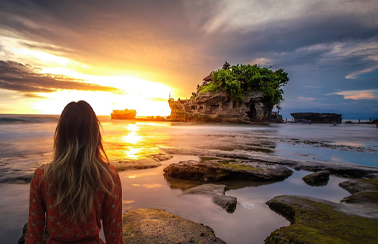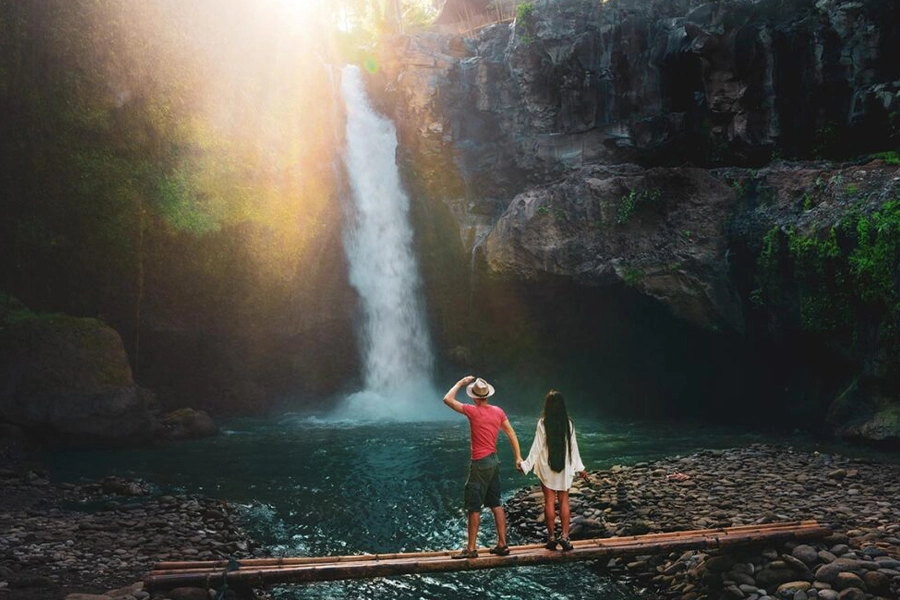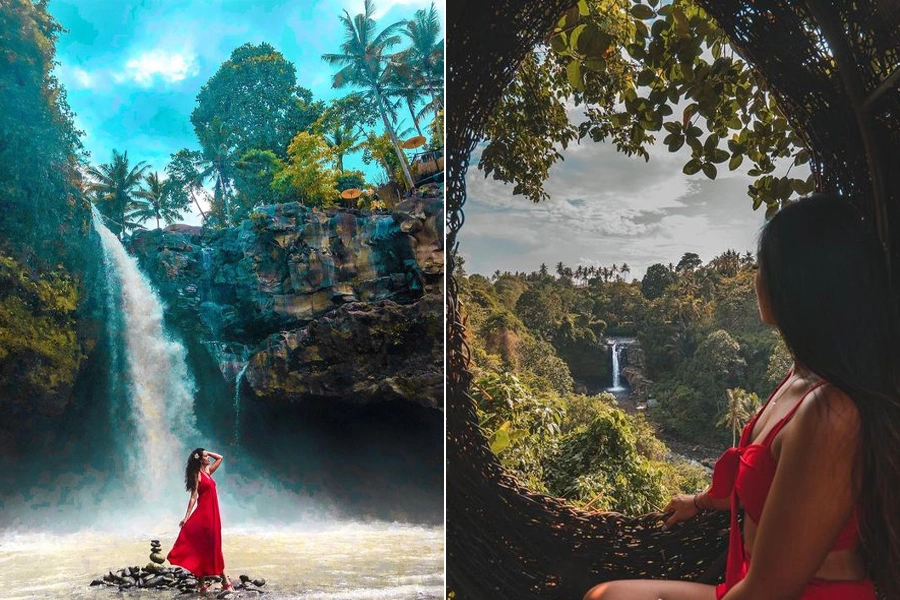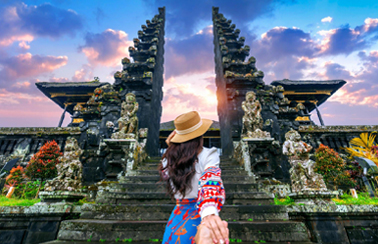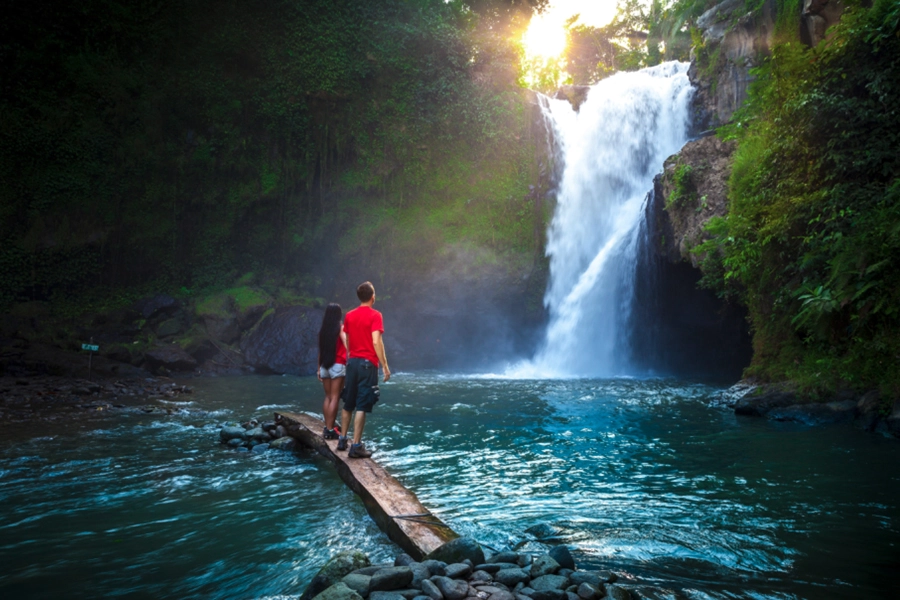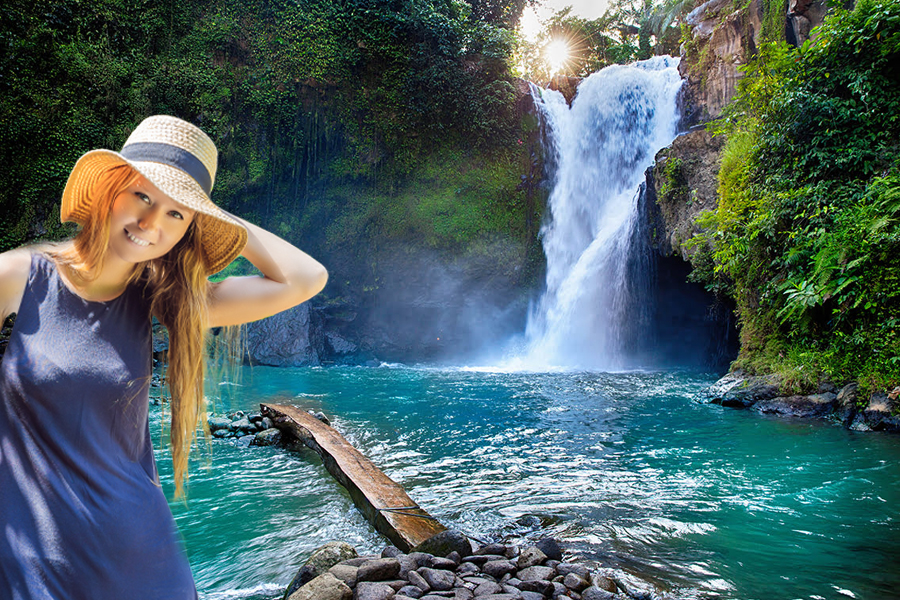Tegenungan Waterfall isn't just a visual feast; it's a playground for the adventurous soul and a haven for those seeking relaxation. Here's a deeper dive into the exciting activities that await you:
Tegenungan Waterfall offers more than just a refreshing dip. It's a place to embrace adventure, unwind in nature's embrace, and experience a touch of Balinese culture. So, come prepared to create unforgettable memories at this hidden gem in Bali.
Tegenungan Waterfall is tucked away in the village of Tegenungan, Gianyar Regency, Bali, Indonesia. It's about 20 kilometers north of Denpasar and close to the famous artist village of Ubud.
Absolutely! Most GPS apps will lead you right there. If you're feeling adventurous, asking locals for directions is also a great option – they're always happy to help!
Is Tegenungan Waterfall worth the hype?
You bet! Picture a cascading waterfall with a cool, inviting pool beneath it. That's Tegenungan in a nutshell. It's a perfect escape from the crowds, offering a refreshing dip and a chance to soak up some stunning scenery.
Is Tegenungan Waterfall big or small?
It's not Niagara Falls, but it's definitely a sight to see! The waterfall itself is around 25 meters high, creating a beautiful plunge pool at the bottom.
Can you swim in Tegenungan Waterfall?
Absolutely! The pool beneath the waterfall is a popular spot for a refreshing dip. Just remember to be cautious and respectful of other visitors.
Should I brace myself for crowds?
Tegenungan can get a bit crowded, especially during peak season (July-August) and on weekends. Aim for an early morning visit, or consider exploring during the shoulder seasons (April-May or September-October) for a more relaxed experience.
How much does it cost to enter Tegenungan Waterfall?
Good news! Entrance fees are super affordable. We're talking around IDR 20,000 for adults (which is roughly USD $1.40) and potentially less for kids. There might also be a separate parking fee, but it won't break the bank. There are lockers and restrooms available for rent at the waterfall for a small fee. You might also want to bring some cash for snacks or drinks from the cafes near the entrance.
What's the best time to visit Tegenungan Waterfall?
The best time to visit is during the dry season (April-May or September-October) to avoid crowds and ensure the water is clear.
How long should I stay at Tegenungan Waterfall?
The beauty of Tegenungan is that you can tailor your visit to your preferences. Spend a quick 30 minutes to cool off, or chill for a couple of hours soaking up the scenery and maybe even grabbing a bite at a nearby cafe.
What should I wear to Tegenungan Waterfall?
When packing for your Tegenungan adventure, comfort is key. Wear comfy clothes, swimwear, and bring a towel if you plan to take a dip. Shoes with good grip are a must as the stairs and rocks can get slippery. Don’t forget sunscreen as Bali's sunshine is intense!
Is there anything else to do at Tegenungan Waterfall besides swimming?
Absolutely! For the adventurous, there are rocks behind the waterfall that can be climbed with caution and proper footwear. You can also relax on the rocks and enjoy the scenery, or even try cliff jumping (at your own risk). There are restaurants and cafes located near the entrance where you can purchase food and drinks to fuel your adventure. Lockers are available for rent at the waterfall for a small fee, allowing you to securely store your belongings while you enjoy swimming and exploring. Restrooms are also available on-site for a small fee.
Is Tegenungan Waterfall accessible for people with disabilities?
Unfortunately, Tegenungan Waterfall requires climbing down stairs to reach the pool, making it challenging for visitors with disabilities.
Is there food and drink available at Tegenungan Waterfall?
Yes, there are restaurants and cafes located near the entrance of the waterfall where you can purchase food and drinks to fuel your adventure.
Are there lockers at Tegenungan Waterfall?
Yes, lockers are available for rent at the waterfall for a small fee. This allows you to securely store your belongings while you enjoy swimming and exploring.
Are there restrooms at Tegenungan Waterfall?
Yes, restrooms are available on-site for a small fee.
What else is there to see and do near Tegenungan Waterfall?
Since Tegenungan is conveniently close to Ubud, why not make a day of it? Ubud is a vibrant town with amazing art markets, delicious food, and rich cultural attractions. Plus, there are other stunning sights nearby like:
- Tegalalang Rice Terraces: Witness the breathtaking beauty of Bali's iconic rice terraces, sculpted into the hillsides.
- Kintamani Volcano: Marvel at the majestic Mount Batur, an active volcano, and enjoy the panoramic views of the surrounding caldera lake.
- Besakih Temple: Explore the "Mother Temple of Bali," a majestic Hindu complex perched on the slopes of Mount Agung.
- Campuhan Ridge Walk: Take a scenic walk along the Campuhan Ridge, offering panoramic views of the valley and lush greenery.
- Ubud Monkey Forest: Encounter playful monkeys in a natural habitat within a protected forest sanctuary.
Is it safe to swim in Tegenungan Waterfall?
The pool beneath the waterfall is generally safe for swimming, but it's always a good idea to be cautious and supervise children closely.
Is cliff jumping allowed at Tegenungan Waterfall?
Cliff jumping is technically possible, but it's important to remember it's at your own risk. Only attempt it if you're an experienced cliff jumper and are comfortable with the height and water depth.
How can I be a responsible tourist at Tegenungan Waterfall?
Here are some tips:
- Respect the environment: Don't litter, and dispose of your trash properly in the designated bins.
- Be mindful of others: Keep noise levels down and be respectful of other visitors enjoying the waterfall.
- Support local businesses: Grab lunch from a nearby cafe or shop for souvenirs from local vendors.
Is it okay to take photos at Tegenungan Waterfall?
Absolutely! Capture those memories and share the beauty of Tegenungan with the world. Just be mindful of other visitors when snapping your pics.
What are some tips for getting great photos at Tegenungan Waterfall?
Here are some tips:
- Arrive early in the morning for the best lighting and fewer crowds.
- Play around with different angles and perspectives to capture the waterfall's grandeur.
What are some fun hashtags to use for my Tegenungan Waterfall photos?
Here are some fun hashtags:
- #TegenunganWaterfall
- #BaliWaterfall
- #UbudAdventure
- #IndonesiaTravel
Are there any other waterfalls worth checking out in Bali?
You bet! Bali is full of hidden gems. Some popular options include:
- Munduk Waterfall: A cascading waterfall surrounded by lush jungle and rice paddies.
- Sekumpul Waterfall: A series of cascading waterfalls hidden within a rainforest, requiring a short trek to reach.
- Nungnung Waterfall: A powerful waterfall with a refreshing plunge pool, surrounded by beautiful scenery.
What if I want to extend my Bali adventure?
There's so much to see and do in Bali! Consider exploring other areas like:
- Nusa Dua: Known for its luxurious resorts and beautiful beaches.
- Seminyak: Famous for its trendy shops, vibrant nightlife, and stylish beach clubs.
Is Tegenungan Waterfall a good place to visit with kids?
Absolutely! The shallow pool at the base of the waterfall is perfect for young children to splash around in (with adult supervision, of course). There's also plenty of space for them to run around and explore the natural surroundings.
Are there any lifeguards at Tegenungan Waterfall?
No, there are no lifeguards on duty at Tegenungan Waterfall. It's important to be extra vigilant and watch your children closely while they're swimming.
Are there any other activities for kids near Tegenungan Waterfall?
Ubud offers a variety of family-friendly activities, such as visiting the Elephant Safari Park, taking a cooking class, or exploring the Blanco Renaissance Museum.
Is there any cultural significance to Tegenungan Waterfall?
While not a major religious site, Tegenungan Waterfall is considered a place of natural beauty and is respected by the local community.
Do you have any tips for respecting local customs while visiting Tegenungan Waterfall?
It's always a good idea to dress modestly when visiting any waterfall in Bali, especially if you plan on entering the water. A simple sarong can be easily purchased locally and is a respectful way to cover up.
